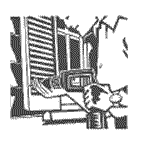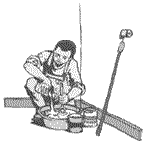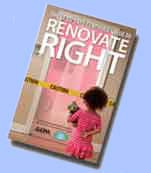 |
 |
HOME | SERVICES | CAREERS | NEWS | INSPECTIONS & TESTING | CONTACT US |
|

| HOME | |
| ABOUT US | |
| KEY PERSONNEL | |
| CONSULTING & SERVICES |
|
| ABOUT ASBESTOS | |
| ABOUT LEAD | |
| GOVERNMENT LINKS |
|
| OTHER LINKS | |
| BOOKS & REFERENCES |
|
| FORM FOR MORE INFORMATION |
|
| CONTACT US | |
|
Information On Recent Events of Environmental Interest: |
|
THE EPA HAS JUST ISSUED STRICT NEW RULES FOR CONTRACTORS |
|
# Why is the RRP Rule important? # To Whom does the RRP Rule apply? # Where does the RRP Rule apply? # What does the RRP Rule require? # What do Contractors need to do? # What Training is required? # Frequently Asked Questions (FAQs) NOTE: On June 18, 2010, EPA announced that it will delay enforcement of the RRP Rule's firm certification requirement and of the worker certification requirement to allow contractors more time to come into compliance. This "delay" does not rescind or revoke or change the basic RRP Rule. EPA will continue to enforce the work practice requirements in the rule. What is being delayed is enforcement of penalties to firms (until October 1, 2010) and to individual contractors (who must be enrolled in a certified renovator class by September 30, 2010. Their training must be co  mpleted by December 31, 2010). mpleted by December 31, 2010).Introduction EPA's Renovation, Repair, and Painting Rule (RRP) went into effect on April 22, 2010. It requires renovation and painting contractors and most other trades who work in pre-1978 housing and who might disturb painted surfaces to become Lead Certified Renovators by taking a "Lead Safe Work Practices" training. A summary of the Rule - with California-related Notes - follows: Why is the RRP Rule important? When lead paint is sanded or scraped or disturbed, microscopic particles of the metal mingle with the dust that is created. That "lead-containing" dust is what can seriously impact people's health, especially children and pregnant women. Lead causes a long list of problems, including learning and behavioral problems, kidney disease, high blood pressure, miscarriage and birth defects. Lead can even cause depression and aggressive behavior. The problems caused by lead, even very tiny amounts of it, would fill an encyclopedia. Lead doubles the number of children in special education classes and is thought to play a major role in our crime rate. There is no safe level of lead in the body. Any is bad for you.  There has been a lot of publicity about toys and other consumer products containing lead. But, problems caused by all of those products put together is a drop in the bucket compared to the number of people harmed when contractors disturb old paint in pre-1978 buildings without taking some simple precautions. There has been a lot of publicity about toys and other consumer products containing lead. But, problems caused by all of those products put together is a drop in the bucket compared to the number of people harmed when contractors disturb old paint in pre-1978 buildings without taking some simple precautions.That's why EPA and the State of California require contractors to protect the people they work for. NOTE: The California regulation is already in effect. The Federal EPA's Renovation, Repair and Painting Rule (or RRP) went into effect on April 22, 2010. To Whom does the RRP Rule apply? The rule applies to all jobs in pre-1978 housing (i.e. "Target Housing") and child occupied facilities where more than 6 square feet per room or 20 square feet outside will be "disturbed" by worker(s) being compensated for the job. The RRP rule covers a lot of jobs: renovation, remodeling, painting, window replacement, plumbing, electrical work, heating & air-conditioning, demolition, plus work performed by trades like carpenters, electricians and handymen. The rule applies to persons working for rental property owners, schools, and day care providers too. It also applies to non-profits and governmental agencies. Where does the RRP Rule apply? The rule applies in Target Housing and Child-Occupied Facilities. Target Housing - is a house or apartment (including mobile homes) built before January 1, 1978 except for: 1) 0-bedroom units (like dorm rooms or studio apartments) 2) housing that is officially designated for the elderly or the handicapped 3) housing that has been tested by a State Certified Lead Inspector and found to be free of lead-based paint. Child-Occupied Facility - is a building, or portion of a building, constructed prior to 1978, visited by the same child, 6 years of age or under, on at least 2 different days within any week, provided that each day's visit lasts at least 3 hours, the combined weekly visit lasts at least 6 hours, and the combined annual visits last at least 60 hours. Such facilities may include, but are not limited to, day-care centers, preschools and kindergarten classrooms. NOTE: On August 26, 2009, EPA announced it plans to, "expand lead safe work practices and other protective requirements for ... work involving lead paint to most buildings, including public and commercial structures, built before 1978."  What does the RRP Rule require? What does the RRP Rule require?1. Pamphlet Distribution - Contractors must give clients a pamphlet called "Renovate Right" and get a signed receipt before beginning a job. NOTE: This is already in effect! Contractors can call (800) 424-5323 and ask for free copies of "Renovate Right" and the "Small Entity Compliance Guide to Renovate Right" or both pamphlets can be downloaded as PDF files from the EPA website. 2. Individual Certification - At least one RRP Certified Renovator is required at each job site. Certification involves taking a 1-day class from an EPA Accredited Training Provider. For class availability visit: RRP Training Note: State Certified Lead Abatement Supervisors and Workers must also become RRP certified, but they only need to take a 1/2 day "refresher" class. For RRP Refresher availability visit: RRP Refresh 3. Firm Certification - In addition to individual certification, each firm, agency or non-profit must also become RRP certified. (Note: This includes city agencies and school districts as well as small "one-man-band" handymen and owners of rental property.) Firms or "entities" must submit an application and pay EPA a fee ($300) which is good for 5 years.  The EPA Firm Certification Form can be downloaded from the EPA web site. Be sure to download the Example as well. You do not need individual certification to submit a Firm Application. Firms should apply as soon as possible. The EPA Firm Certification Form can be downloaded from the EPA web site. Be sure to download the Example as well. You do not need individual certification to submit a Firm Application. Firms should apply as soon as possible.According to the EPA, after April 22, 2010, "... no firm working in target housing or child-occupied facilities, where lead-based paint will be affected by the work, may perform, offer or claim to perform renovations without EPA Firm Certification." Firm certification is not the same as the personal (or individual) certification attained by successful completion of an RRP course. There is no training requirement for Firm Ciertification. Note: Lead Abatement firms must also become RRP Certified if they do non-abatement jobs. 4. On-the-Job-Training - RRP Certified Renovators are rerquired to train all non-certified people at the job site. NOTE: Contractors who do business with agencies receiving Federal money for housing rehabilitation, etc must have everyone trained in the classroom. 5. Paint Testing - The rule requires contractors to either test paint they will disturb BEFORE beginning a job, or assume that it is lead-based. This testing is to be done by the contractor, using EPA-approved test kits. Note: However, in California contractors may not test paint. Instead, current law requires that they must assume that all surfaces in all structures built before 1978 contain lead-based paint. The only people who can test for lead-based paint in California are State Certified Lead Inspectors/Risk Assessors. 6. Use Lead Safe Work Practices - The RRP Rule requires that "Lead Safe Work Practices" be used when disturbing 6 sq feet per room or 20 sq feet outside. NOTE: California already requires that "Lead Safe Work Practices" be used in all pre-1978 structures when disturbing any amount of known or "presumed" lead-based paint. "Lead Safe Work Practices" aren't difficult or costly. Buying a good HEPA vacuum is probably the biggest expense. Shop vacs with HEPA attachments are not allowed. Certified HEPA vacuums are the only type of vacuum permitted under the RRP Rule. 7. Cleaning Verification - At the end of each job, contractors are required to do a "cleaning verification" to make sure they cleaned up properly. They wipe a cleaned area with a white cloth and then compare the cloth against a picture on a laminated card given to them during training. If the cloth is lighter than the picture on the card, the area is considered to be clean. NOTE: This is the most controversial part of the regulation. Standard procedure after most lead jobs is to hire a 3rd-party State-Certified Lead Inspector to take (clearance) dust samples for laboratory evaluation to confirm that no lead hazards remain. Last August, EPA announced that it intends to expand protective requirements of the RRP Rule, "to require renovation firms to perform quantitative dust testing to achieve dust-lead levels that comply with EPA's regulatory standards." We think that means Clearances may be required in some - not all - instances. What do Contractors Need to Do? 1. Sign up for an EPA Accredited RRP Class or call HomeSafe at (800) 648-5323. NOTE: Lead Abatement Workers & Supervisors already state certified should sign up for a 4-hr RRP Refresher. 2. Obtain free copies of "Renovate Right" and the "Small Entity Compliance Guide to Renovate Right" by calling 800-424-5323 or, download them from the EPA Publications page. 3. Purchase a good quality HEPA vacuum (if you don't already own one). They are available from most Remediation or Environmental Equipment suppliers. 4. For more about the RRP Rule visit the: EPA RRP Web Page. Frequently Asked Questions These are questions we asked our EPA contacts and the answers we received. NOTE: For additional RRP-related FAQs visit the EPA FAQ Pages. . Q: Are public schools subject to the RRP rule? A: Yes, RR&P applies to all schools public, private and alternative. Q: If I have three apartment buildings - each it's own LLC - and I work on each of them as owner, do I need three firm certs? A: Only one firm certification and only one project overseer needs to have the eight hours of training for the apartment maintenance unit regardless of the number apartments handled. Q: While the rule specifically mentions "surface coatings" such as paint, varnish or shellac, it does not mention stain. Are stained surfaces subject to the RRP Rule? A: Yes, comes under coatings. Q: Do workers need to be trained in a task - say wet sanding - at every job, or once trained are they considerd trained for all successive jobs? A: On-the-job training is required at every job except when you can document that a worker has been previously trained. Q: If I am a handyman working alone do I need a Firm certification? A: Yes, to work on pre-78 structures, you will need both the individual and the firm certifications. Q: I live in one unit of a duplex I own and rent the other. Do I need RRP certification? A: Yes, if you do maintenance or repair work on the rental unit. You will need both the firm and individual certifications. By the way, rent is considered compensation under the rule. |
|
Is there lead in your child's juice box?
An environmental group finds potentially health-threatening levels of lead in many juice boxes and fruit snacks. How worried should parents be? posted on June 23, 2010, at 7:00 AM http://theweek.com/article/index/204095/is-there-lead-in-your-childs-juice-box Could her juice box be harmful to her health? Photo: Corbis |
 As if parents didn't have enough worry about: A Californian environmental group says it has found traces of lead in some juice drinks and packaged fruit at levels far exceeding state and federal daily limits. Here, a quick guide to the findings and what they mean for families:
As if parents didn't have enough worry about: A Californian environmental group says it has found traces of lead in some juice drinks and packaged fruit at levels far exceeding state and federal daily limits. Here, a quick guide to the findings and what they mean for families: